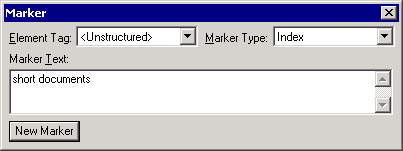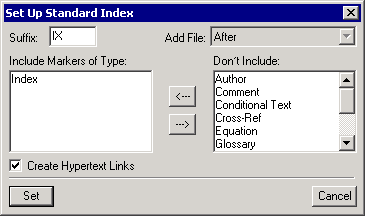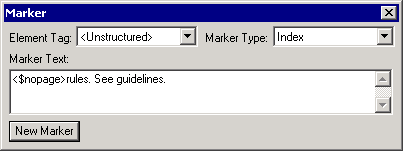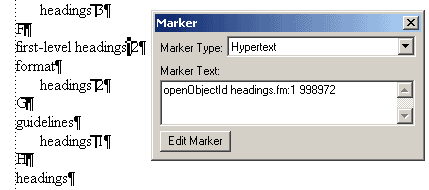FrameMaker 7.0 Tutorial: Indexes
Downloading and Saving the Source Document
An index can be generated from either a single document or a book. The document or book that the index is generated from is called the source document. For this tutorial, the source document (in this case, a single document) has already been created for you. Before you begin, download and save the source document.
To download the source document:
- Select the following link: indexes.mif.
Note: Earlier versions of Netscape may attempt to display this file directly. To force Netscape to download this file, right-click the link above, and select Save Link Target As. - Select the directory in which to save the file, and click Save.
Note: If you are working in the TCM computer lab, save the file to your lab account. If you do not have a lab account, please contact your instructor.
To save the source document:
- Open FrameMaker, and select File > Open.
- Change to the directory in which you saved the source document.
- Select index.fm, and click Open. (If messages appear, click OK to continue.)
- Select File > Save As.
- Select the directory in which to save the file.
- In the File name box, change .mif to .fm.
- Click Save.
Marking Simple Index Entries
To mark a simple index entry:
- With the indexes.fm file open, turn on Borders, Text Symbols, and Rulers.
- Select Special > Marker.
- Highlight the words short documents located in the second paragraph on page 2.
The text appears in the Marker dialog box.

- Select Index from the Marker Type pull-down menu.
- Click New Marker.
FrameMaker places (index marker) to mark the index entry.
(index marker) to mark the index entry.

Tip: To view the contents of a marker, select the marker symbol while the Marker dialog box is open. The contents of the marker are displayed in the Marker dialog box. - Highlight the word phrasing located in the third paragraph on page 2.
- Click New Marker.
- Highlight the words lone headings located in the fourth paragraph on page 2.
- Click New Marker.
- Click
 to close the Marker dialog box.
to close the Marker dialog box.
Generating an Index
After you have created index markers in your document, you are ready to generate an index.
To generate an index for an individual document:
- Select Special > Standard Index.
The following message appears.

- Click Yes.
The Set Up Standard Index dialog box appears.

- Verify that Index is the only marker listed under Include Markers of Type. (If Index is not included, locate the marker in the Don’t Include list, and double-click it.)
- Click Set.
The index appears in your document window. FrameMaker generates your index in a new file called indexesIX.fm. (The name of the source document plus the suffix “IX”.)
Note: To get a better look at your index, you can hide text symbols by deselecting Text Symbols from the View menu.
| Note: You can generate an index for an entire book by selecting Standard Index from the Add menu. |
Formatting the Index
After placing the index markers and generating the index, you can improve the formatting to make the index more readable. To format the index, follow the steps below:
- Place your cursor in the first line of your index. (This paragraph should be tagged GroupTitlesIX.)
- Open the Paragraph Designer (Ctrl + M), and click the Basic tab.
- From the Space Above Pgf pull-down menu, select 1 Line (14.0 pt), and click Update All.
- Click the Default Font tab.
- From the Family pull-down menu, select Arial.
- From the Weight pull-down menu, select Bold, and click Update All.
- Place your cursor at the very beginning of your document (first line, first position), type the word INDEX, and press Enter.
- Place your cursor within the word INDEX, and select Title from the Paragraph Tag pull-down menu.
- Click Update All, and close the Paragraph Designer.
| Note: The index will retain this formatting through new generations, as long as you do not change the name of the source document. |
Adding Markers for Nested Index Entries
To add nested entries to your index:
- Return to the indexes.fm file, and select Special > Marker.
- Highlight the words stacked headings located in the fifth paragraph on page 2.
- Click New Marker.
- Within the same text, highlight the word headings.
- Within the Marker dialog box, type a colon and the word stacked immediately following the word headings.
Your marker text should look similar to the following.

- Click New Marker.
- In the previous paragraph, add a similar index marker for lone headings.
- Generate the index.
- Press and hold the Shift key, and select File > Save All Open Files to save your files.
Adding an Entry for a Range of Pages
To include an entry for a topic that spans several pages:
- Within the indexes.fm file, place your cursor anywhere in the first paragraph on page 2.
- In the Marker dialog box, type <$startrange>lists.
Your marker text should look similar to the following.

- Click New Marker.
- Place your cursor anywhere in the last paragraph on page 3.
- In the Marker dialog box, type <$endrange>lists.
- Click New Marker.
Adding an Entry without a Page Number
To include an entry without a page number:
- Place your cursor anywhere in the first paragraph on page 2.
- In the Marker dialog box, type <$nopage>rules. See guidelines.
Your marker text should look similar to the following.

- Click New Marker.
- Click
 to close Marker dialog box.
to close Marker dialog box.
- Generate the index.
- Press and hold the Shift key, and select File > Save All Open Files to save your files.
The index is still very simple, but it contains the most common index elements. Experiment with creating and formatting indexes, such as a two-column layout, for other FrameMaker documents.
As you develop an index, you are likely to find entries that you want to change in the source files (for example, the files for the actual chapters of your book). FrameMaker enables you to link directly to the file and to the index tag that you want to change. You don’t have to laboriously open the source file and search for the tag. Here’s how:
- Open the index document you have just generated. Make sure that View > Text Symbols is checked.
- Click Special > Marker to display the Marker dialog. Unless you have accidentally selected an index marker, this dialog box will be empty.
- Click in the text near the index marker you want to change. There are two ways to select an index marker that you want to change:
- Move your cursor just inside the index marker, which looks like a big
 . Hold down Shift (in Windows) and press the right arrow once or twice until some text appears in the Marker dialog boxor
. Hold down Shift (in Windows) and press the right arrow once or twice until some text appears in the Marker dialog boxor - Use your mouse to select enough of the index marker so that text appears in the Marker dialog box.
Either way you accomplish this task, the results will look like this; the index marker just after first-level headings is highlighted by about the space between the s and the 2.

- To go to the index tag in the source, hold down Ctrl and Alt (in Windows), move the mouse pointer over the selected index marker, and when the pointer turns into a hand, click the mouse. FrameMaker will open up the file that contains the index tag you want to change and display the index entry in the dialog box:

- Make the necessary changes and click Edit Marker.


Comments